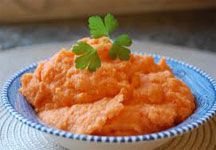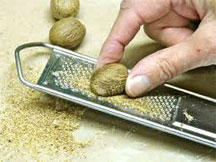Scintillating Sides!
By Alice Osborne
Did you know that in chef-talk, mashed potatoes is also known as a vegetable puree? I didn't either. And did you know that LOTS of vegetables can be pureed and combined with wonderful herbs and seasonings to create some very scintillating side dishes?
 It's all true. We tend to think of vegetable puree in terms of baby food, but really it's the baby food industry that got the idea from world class chefs who've been serving vegetable purees as delightful alternatives to mashed potatoes for many decades.
It's all true. We tend to think of vegetable puree in terms of baby food, but really it's the baby food industry that got the idea from world class chefs who've been serving vegetable purees as delightful alternatives to mashed potatoes for many decades.
To puree a vegetable is to mash it to a smooth consistency. Virtually any vegetable that can be cooked until soft can be made into a puree. And this is the season of root vegetables (besides potatoes, I mean) - carrots, yams, sweet potatoes, parsnips, winter squashes. Add to this list broccoli, cauliflower, Brussels sprouts, lima beans and green peas, and the hardy greens such as spinach, kale, collards, and mustard greens, and you have a full arsenal of wonderful puree opportunities.
 Vegetables can be pureed by forcing them through a food mill, hand mashing with an old-fashioned potato masher, or by zapping them quickly in a food processor or blender. (ALERT: Never whip potatoes in a food processor; its high-speed blade breaks down the starch and the potatoes become gluey.) Forcing veggies through a food mill gives the finest texture.
Vegetables can be pureed by forcing them through a food mill, hand mashing with an old-fashioned potato masher, or by zapping them quickly in a food processor or blender. (ALERT: Never whip potatoes in a food processor; its high-speed blade breaks down the starch and the potatoes become gluey.) Forcing veggies through a food mill gives the finest texture.
And speaking of a food mill, this tool is a real work saver. A food processor may be faster, but a food mill is cheaper and is easily taken apart for thorough cleaning. It also comes in handy for many other jobs such as ricing potatoes, making jelly and applesauce, for turning cooked rice into a thickener for soups, or for making homemade baby food.
 And speaking of baby food, let's now return to vegetable purees. The starchiness of a vegetable determines the thickness the puree. Carrots, spuds, winter squash, peas, and cooked dried beans, for example, produce thick purees; green beans, broccoli, and asparagus produce thin ones.
And speaking of baby food, let's now return to vegetable purees. The starchiness of a vegetable determines the thickness the puree. Carrots, spuds, winter squash, peas, and cooked dried beans, for example, produce thick purees; green beans, broccoli, and asparagus produce thin ones.
Purees made with starchy vegetables make the best side dishes served along with roasts and other meats, poultry, and fish. They can also be stirred into soups, stews, and gravies to thicken and flavor them. Thinner purees enhance with herbs, fruit juices, and flavored vinegars instead of butter, can be used as low-fat sauces and flavorings for meat, fish, and pasta.
 When you want to flavor a puree, remember that a light hand is best when adding herbs and seasonings. The flavor of the vegetable should dominate, not the seasoning. When in doubt, a pinch of freshly grated nutmeg always works.
When you want to flavor a puree, remember that a light hand is best when adding herbs and seasonings. The flavor of the vegetable should dominate, not the seasoning. When in doubt, a pinch of freshly grated nutmeg always works.
Purees can be refrigerated for up to 4 days and frozen for 1 month in tightly covered containers. When reheating a frozen puree, add a small amount of liquid and heat in a heavy saucepan, stirring constantly, over very low heat or use a double boiler (always my preference because I don't have to stand and babysit it).
 To conclude, here's one of our favorite puree combos, using a vegetable most folks run away from - Brussels sprouts. I combine 2 cups (fresh or frozen) puree with 1 medium sauteed onion, at least 2 tablespoons of butter, 1/2 cup of plain yogurt, a pinch of nutmeg, and some salt and pepper to taste. This is an amazing side dish - folks won't believe it's actually Brussels sprouts.
To conclude, here's one of our favorite puree combos, using a vegetable most folks run away from - Brussels sprouts. I combine 2 cups (fresh or frozen) puree with 1 medium sauteed onion, at least 2 tablespoons of butter, 1/2 cup of plain yogurt, a pinch of nutmeg, and some salt and pepper to taste. This is an amazing side dish - folks won't believe it's actually Brussels sprouts.
So going forward with your holiday and winter meals, consider including some pureed vegetables as alternatives to those well-loved, but oh-so-common mashed potatoes. You'll add some scintillating flavor as well as probably spark some scintillating conversation around what you've done!

